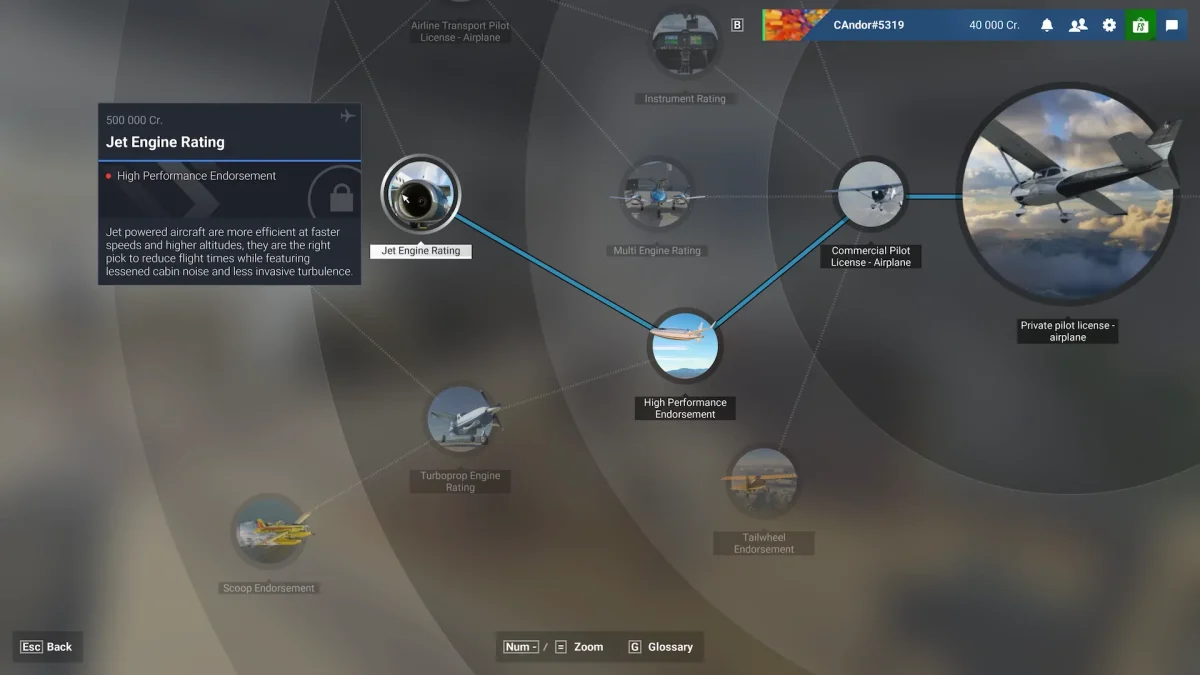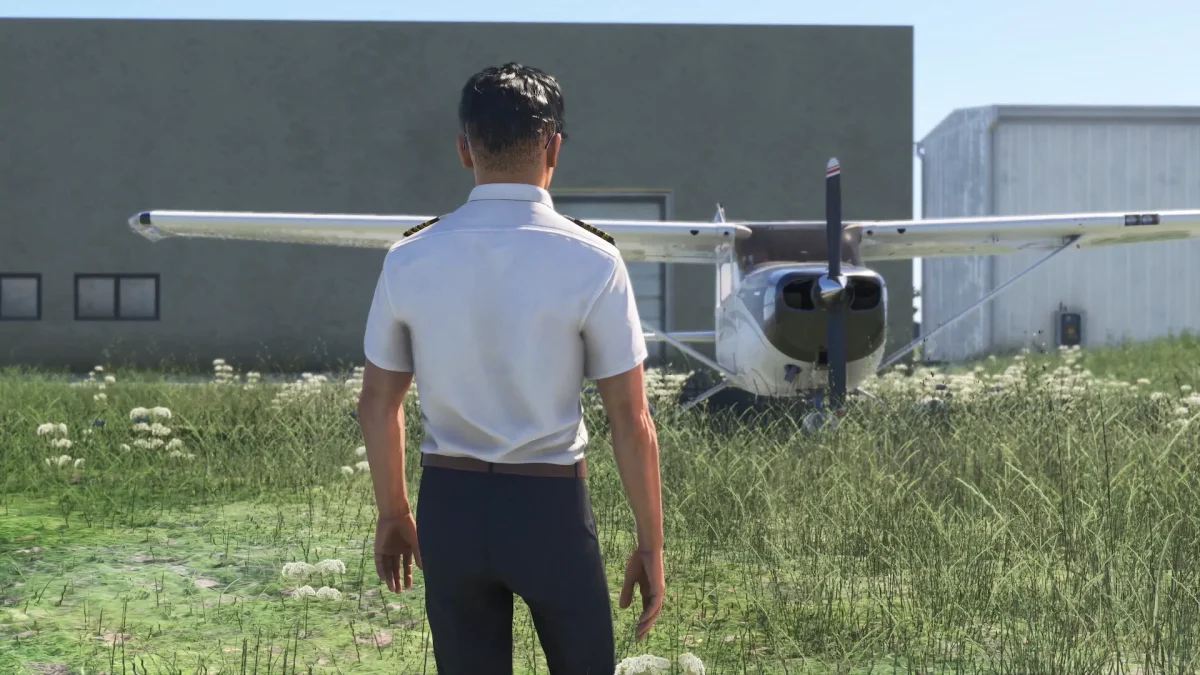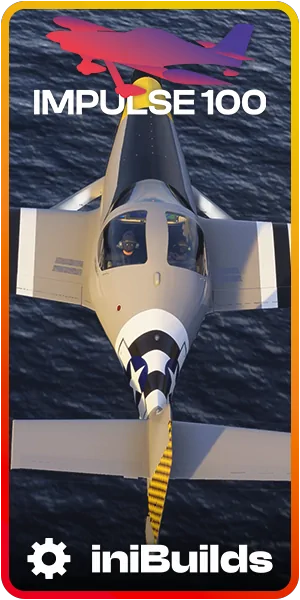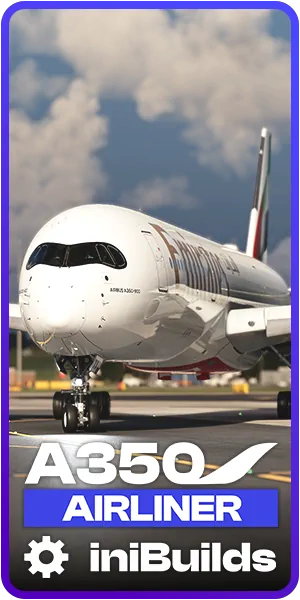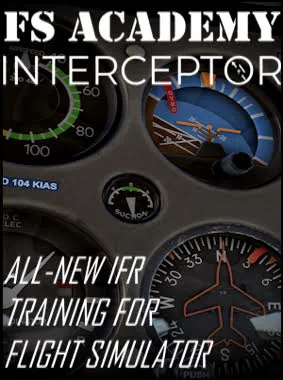Microsoft Flight Simulator 2024 Fully Detailed: A Comprehensive Look at the Next-Gen Sim
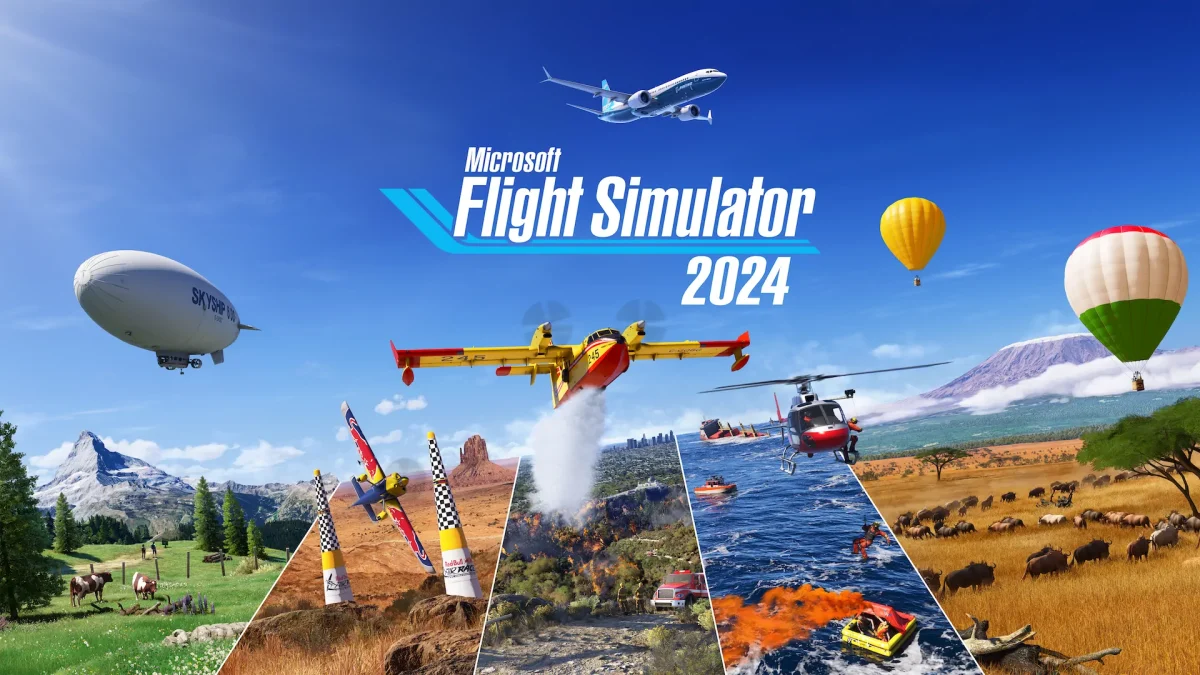
1. Introduction
1.1 The Vision for Microsoft Flight Simulator 2024
1.2 Reaching New Heights Through Community Feedback
1.3 The Explosion of Interest in Flight Simulation
2. Technological Advancements
2.1 Cloud-Based Streaming Architecture
2.2 Backward Compatibility
2.3 Enhanced World Rendering
2.4 Flight Modeling and Physics
2.5 Air Traffic and ATC
2.6 VR Optimizations
3. Expanded Avionics and Aircraft Fleet
3.1 A Comprehensive Avionics Suite
3.2 Full List of Aircraft: 45 New, 50 Improved from MSFS 2020
3.3 Realistic Pre-Flight and In-Flight Tools
4. A Living, Dynamic World
4.1 Enhanced Global Representation
4.2 Aviation Infrastructure Improvements
4.3 Wildlife and Ecosystem Simulation
5. Career Mode and Aviation Activities
5.1 Structured Aviation Experiences
5.2 Career Mode – Building Your Aviation Legacy
5.3 Dynamic Mission System
5.4 Aviation Specializations and Job Types
5.5 Evaluation and Reputation System
5.6 From Employee to Business Owner
5.7 Challenge League – A Competitive Mode
5.8 Photographer Mode – Capturing the World’s Beauty
6. Marketplace and Content Updates
6.1 Redesigned Marketplace: Better Discovery, Renting, and Gifting
6.2 Updated Tutorials and Missions
6.3 Continuous Content Updates: A Simulator for the Future
7. Editions and Pre-Order Information
7.1 Available Editions
7.2 Pre-Orders and Exclusive Content
8. Conclusion
1. Introduction
1.1 The Vision for Microsoft Flight Simulator 2024
The time has come! After more than a year since a surprising announcement started generating expectations around the next generation of Microsoft’s oldest franchise, the veil is beginning to lift on everything that Microsoft Flight Simulator 2024 brings to a community of hardcore enthusiasts and a new audience fascinated by aviation and ready to dive into the hobby.
Indeed, the flight simulation community is one of the most dedicated in the industry, but it also needs assurance that the hobby will remain alive for years to come. When MSFS 2020 was released four years ago, it essentially resurrected an interest that had been dormant for several years. And it did so with a simple strategy: attracting new audiences to flight simulation and thus ensuring the economic sustainability of the platform—the best of both worlds. Microsoft Flight Simulator 2024, set to launch on November 19th, takes a huge leap forward in realizing this vision.
In early September 2024, Microsoft organized a special media event in the Grand Canyon that served as a Global Preview Event for Microsoft Flight Simulator 2024. There, the team behind MSFS and key partners presented the ambition and scale of the new version. In a one-and-a-half-hour presentation and through insights provided by the development team throughout the day, we got the most in-depth look yet into the new sim, including hands-on time with a pre-release version that fully displays the sheer scope and ambitions behind this project. It’s truly impressive, so let’s dive deep into everything we learned and what exactly you can expect from Microsoft Flight Simulator 2024.
Microsoft Flight Simulator 2024 promises to redefine flight simulation, building on the success of its 2020 predecessor. This version brings new technological advancements and a rich array of aviation content, shaped largely by feedback from the passionate simming community. Jorg Neumann, Head of Microsoft Flight Simulator, emphasized how deeply the development team is connected with its users, saying during the presentation that the community feedback “fuels the team.” This close relationship with the community has influenced every aspect of the simulator’s evolution.
1.2 Reaching New Heights Through Community Feedback
One of the pillars of Microsoft Flight Simulator 2024’s development is the continuous feedback from the user base. According to Neumann, over the past 4 years the developers aimed to engage closely with their audience, resulting in 49 updates in 49 months since the release of Microsoft Flight Simulator 2020. These updates included:
- 18 world updates
- 15 sim updates
- 9 city updates
- Aircraft and avionics updates
Neumann noted that the community consists of three major types of users: core simmers, gamers, and digital tourists. This diverse audience has driven the developers to create experiences that cater to all, from serious flight enthusiasts to those who explore the world casually.
1.3 The Explosion of Interest in Flight Simulation
Neumann highlighted the unprecedented growth in interest for flight simulation. Since Microsoft Flight Simulator launched over 42 years ago, the franchise has attracted 45 million simmers. Remarkably, 15 million of those users came in just the last four years, following the release of the 2020 version.
Neumann described this surge as an “explosion in the hobby of flight simulation,” driven by advances in technology and the expanded accessibility of the simulator across multiple platforms. The influx of new simmers includes many “digital tourists,” individuals who primarily use the simulator to explore the world from a bird’s-eye view, often without much interest in aviation.
2. Technological Advancements
2.1 Cloud-Based Streaming Architecture
At the heart of these changes is a fundamental shift in how the simulator operates. Moving much of the data to the cloud allows for more dynamic content, better performance on lower-end hardware, and a significant reduction in the simulator’s local storage footprint.
One of the most important technological shifts is the transition to a cloud-based streaming architecture. Sebastian Wloch explained how the size of the sim’s install had ballooned in Microsoft Flight Simulator 2020, with world updates and third-party add-ons increasing the overall content to the point where users had to manage hundreds of gigabytes of data on their local machines.
In Microsoft Flight Simulator 2024, the majority of content will now be stored and streamed directly from the cloud. Wloch explained, “We only download what is actually seen at the moment,” which drastically reduces the need for large local storage. This streaming architecture means that the simulator will only download what the user is currently experiencing, such as airports, planes, and scenery in the immediate area of flight.
This shift has several benefits:
- Faster loading times: Players can jump into the simulator much quicker, reducing the long wait times experienced in Flight Simulator 2020.
- Smaller install size: The local installation will no longer balloon to hundreds of gigabytes, as everything that isn’t immediately needed will remain in the cloud.
- Improved performance on lower-spec machines: With the bulk of the content being handled by the cloud, even lower-end machines can run the simulator more efficiently.
2.2 Backward Compatibility
Despite the heavy reliance on cloud technology, Wloch reassured users that backward compatibility remains a priority. The ability to use locally stored mods, add-ons, and community-created content will continue to be supported through the Community Folder. This folder will function similarly to the one in MSFS 2020, allowing users to add and manage their modifications without being affected by the shift to cloud-based storage.

2.3 Enhanced World Rendering
One of the most jaw-dropping improvements revealed by Sebastian Wloch was the incredible increase in terrain detail. The 2020 version introduced photogrammetry cities and detailed landscapes, but Microsoft Flight Simulator 2024 takes this to an entirely new level and this is even, in Jorg Neumann’s words, the “main innovation” in this new version of the sim. Wloch explained that the new version features 4,000 times more detail in its terrain rendering compared to the previous simulator!
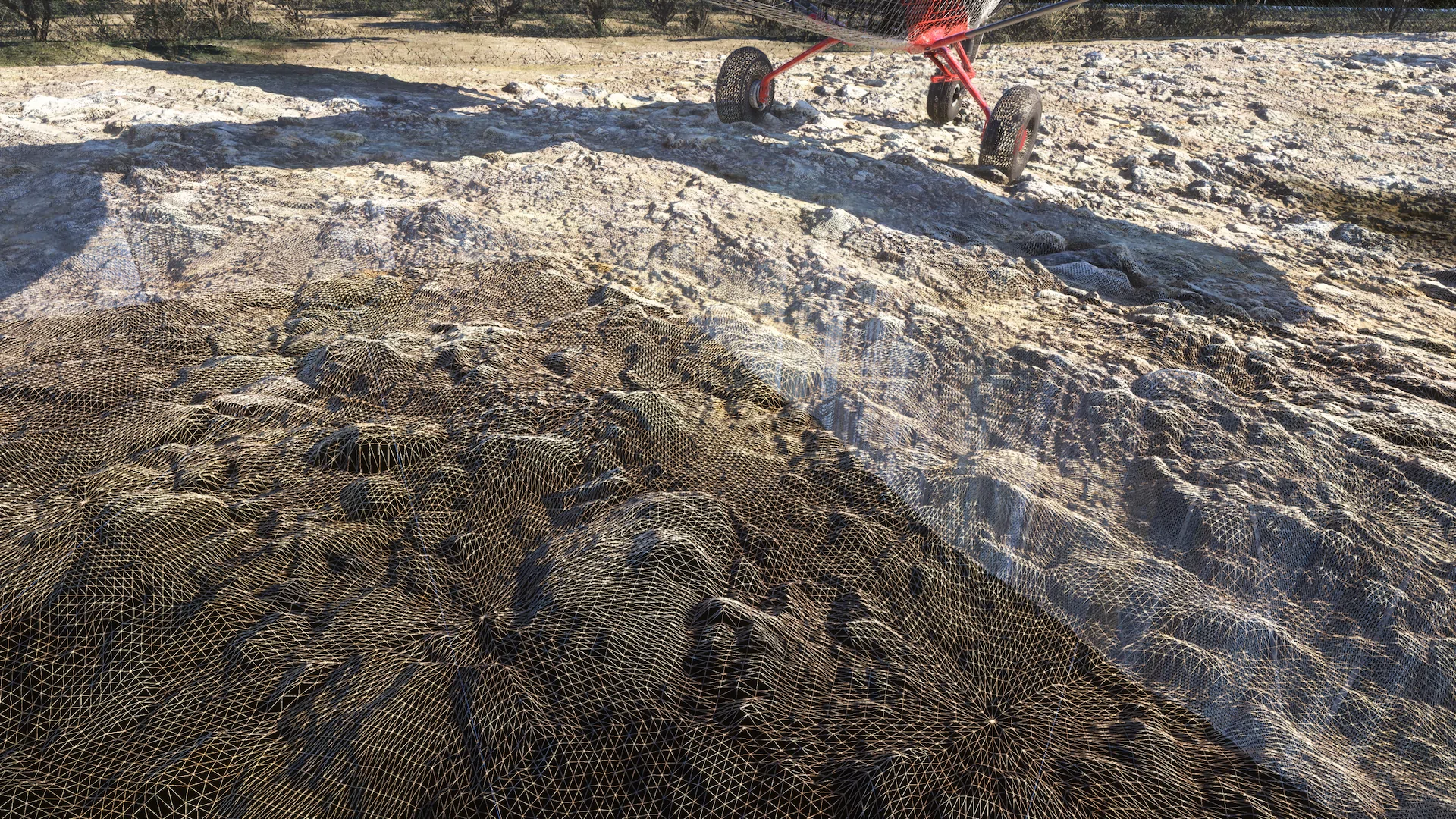
He illustrated this with a side-by-side comparison of terrain wireframes. In MSFS 2020, the ground polygons were relatively large and lacked fine detail when viewed up close. In contrast, MSFS 2024 breaks the terrain down into far more granular polygons, accurately simulating rocks, cracks, and even individual stones. This leap in terrain resolution is particularly important for helicopters, bush planes, and gliders, as it allows for more realistic interaction with the ground during landings and low-altitude flights.
Wloch elaborated on the significance of this improvement: “The ground really is meaningful now when you land or take off, and all this detail is now accurately simulated.“

Improved Textures and Displacement Mapping
Beyond the terrain geometry, the surface textures have also been upgraded. Wloch showcased an example of displacement mapping, where 3D elements such as rocks or cracks in the runway are now physically modeled, making them more than just flat textures. This makes landing and takeoff surfaces more immersive and challenging, especially in off-airport landings or bush flying scenarios.
Runway markings, taxi lines, and airport surfaces are now rendered with unparalleled detail. Wloch compared 2020’s airport surfaces, where painted lines appeared pixelated when zoomed in, to the new 2024 version, which features crisp, highly detailed textures even at close range. These improvements extend to both small airfields and large international hubs, enriching the realism for all types of flying.
Dynamic Seasons and Biomes
For the first time in the series, seasons are fully implemented in Microsoft Flight Simulator 2024. Players will experience dynamic seasonal changes, where landscapes transform throughout the year to reflect real-world climate shifts. Sebastian Wloch detailed how the team integrated over 23 different biomes, each with its own distinct plant species and environmental characteristics. These biomes will change color and texture with the seasons, making each flight feel different depending on the time of year.
- Autumn: Trees lose their leaves, vegetation turns orange and yellow, and the landscape takes on the warm hues of fall.
- Winter: Snow will accumulate on the ground, lakes will freeze, and the world will be covered in a blanket of white. The snow isn’t just cosmetic—it interacts with aircraft as they land or take off, leaving realistic tracks and affecting the performance of planes in colder environments.
- Spring and Summer: Plants regrow, flowers bloom, and the landscape returns to vibrant greens. These seasons showcase the rich diversity of the world’s biomes, from tropical rainforests to arid deserts.
The integration of seasons isn’t limited to the visuals. Wloch explained how Microsoft Flight Simulator 2024 takes seasonal changes into account for the physics of flight as well. In winter, snow and ice can affect takeoff distances and handling, while in summer, thermals and high temperatures will influence glider and lighter aircraft performance.

Advanced Sky and Weather Systems
Another critical enhancement is the overhaul of the sky and weather systems. The cloud system, which was already a standout feature in the 2020 version, has been further improved to simulate real-world cloud dynamics more accurately. Sebastian Wloch shared that clouds are now more realistically simulated, and the atmospheric lighting has been completely reworked. This results in more accurate color grading and smoother transitions as the sun moves across the sky.
One of the key advancements is how different layers of the atmosphere affect light. For example, during sunset, clouds at different altitudes receive different levels of sunlight. High clouds may still be brightly illuminated, while lower clouds take on a darker, more muted color as the sun dips below the horizon. Wloch explained that this change reflects real-world physics and makes for a much more immersive flying experience.
MSFS 2024 will also have better simulation of visibility, with the ability to create layers of fog or pollution near the ground. And there’s also tornadoes in missions and Aurora Borealis, which users will be able to see on specific dates in the sim.
Live Weather
Weather has always been a central part of Microsoft Flight Simulator, and in the 2024 version, live weather data is even more seamlessly integrated into the simulation. Players will experience real-time weather conditions, including thunderstorms, heavy winds, and turbulence, all powered by live data. Wloch highlighted that the new weather system allows for greater variation in conditions, particularly in more challenging weather situations like tropical storms or blizzards.
MSFS 2024 also introduces 24-hour historical weather, allowing pilots to experience weather conditions from earlier in the day.
The improved weather engine not only affects how the world looks but also impacts flight dynamics. Furthermore, pilots will finally be able to make use of their aircraft’s windshield wipers, which are now fully functional in MSFS 2024! This feature enhances realism in adverse weather, improving visibility and adding a new layer of cockpit management during wet conditions.
Flying through thunderstorms, for example, will require pilots to carefully navigate the turbulence and rapidly changing wind conditions. Wloch demonstrated a thunderstorm over JFK Airport in New York, showing how the cloud layers, lighting, and atmosphere combine to create a truly immersive weather event.
Water Physics and Interaction
In Microsoft Flight Simulator 2024, water is no longer just a flat surface—it now interacts dynamically with aircraft and the environment. Sebastian Wloch demonstrated how water behaves in 3D, with waves that can affect seaplanes and amphibious aircraft. Pilots will need to pay attention to wave direction and height when taking off or landing on water, as these factors will now have a significant impact on the difficulty of the maneuver.

Dynamic Ground Interaction and Footprints
An exciting new feature is the way aircraft now leave traces on the ground. Whether it’s a jet landing on a runway, a bush plane touching down on soft terrain, or a helicopter creating turbulence over a grassy field, the ground reacts dynamically to the weight and force of the aircraft. Wloch demonstrated how planes leave tracks in the snow, push down tall grass, and leave skid marks on tarmac. These effects are generated based on real physics, making the interaction between the aircraft and the environment feel more tangible than ever before.
This system also includes how the terrain deforms in real-time. Soft ground, like snow or sand, will change shape under the weight of the aircraft, and pilots will need to account for this when choosing landing sites outside of traditional airports. This is especially relevant for bush flying and helicopter missions, where off-airport landings are common.
Photometric Lighting and Ray Tracing
The lighting engine in Microsoft Flight Simulator 2024 has also seen a major upgrade. Photometric lighting now ensures that all light sources, from the sun to streetlights, have realistic intensities and temperatures. Wloch shared that the new lighting system can handle extreme contrasts, such as the blinding brightness of the sun at high noon versus the dim glow of a candle at night. This creates more natural transitions between light and shadow, especially in low-light situations like dawn and dusk.

Additionally, ray tracing has been implemented to enhance the way light interacts with surfaces inside and outside the aircraft. Cockpit shadows are now much sharper and more accurate, with soft edges depending on how far the light source is. Reflections on glass, the metal surfaces of planes, and even small scratches on cockpit windows are now rendered with incredible realism, bringing the visual fidelity of Microsoft Flight Simulator 2024 to a new level.
2.4 Flight Modeling and Physics
One of the cornerstones of Microsoft Flight Simulator 2024 is the enhanced flight physics and aircraft modeling, which aim to deliver the most realistic flying experience to date. Sebastian Wloch explained that the team has reworked key elements of the flight model, bringing in several new systems designed to simulate every aspect of an aircraft’s behavior. The goal was to go beyond what was achieved in 2020 by adding complexity and fidelity to how aircraft interact with their environment, including more realistic aerodynamic forces and airflow dynamics.
Four New Simulation Systems
Wloch introduced the four interconnected systems that form the backbone of the flight model in Microsoft Flight Simulator 2024. These systems allow for a more detailed simulation of how aircraft move through the air and interact with the environment around them. Each system operates on different scales, from small details like wing surfaces to large atmospheric phenomena.
- Surface Dynamics: This system was present in Microsoft Flight Simulator 2020, but in the 2024 version, it has been significantly expanded. The previous model allowed aircraft to have a fuselage and a wing, but now, more complex shapes are possible. Wloch explained that aircraft can now have multiple wings, complex surfaces, and even different shapes that react accurately to airflow. This provides a more realistic simulation of aircraft like delta wings or double-deckers.
- Computational Fluid Dynamics (CFD): This system simulates the flow of air around the aircraft. In the 2024 version, it has been upgraded to include the impact of engines on airflow. For example, when an aircraft is stationary on the ground and the engine is powered up, the air from the engine will hit the tail and affect the aircraft’s stability. This also includes ground effects, turbulence, and other aerodynamic phenomena that are essential for simulating real-world flying, especially for helicopters and gliders.
- Wake Turbulence and Vortex Simulation: This new system tracks airflow and turbulence over a large area, extending up to six minutes in the past and covering a distance of over 10 kilometers. This allows for the accurate simulation of wake turbulence, which is critical when flying behind larger aircraft. Wloch pointed out how important this is for realism: “If you’re a small aircraft taking off behind a big airliner, the turbulence they leave behind can throw you out of the sky if not handled properly.”
- Atmospheric Simulation: Extending beyond the immediate surroundings of the aircraft, this system simulates the large-scale movement of air caused by natural phenomena like the sun heating the Earth’s surface. Turbulence, thermals, and wind currents are all part of this system, which plays a major role in soaring, gliding, and low-altitude flying. Wloch demonstrated how the system creates updrafts and downdrafts depending on the time of day and weather conditions.
Realistic Airflows and Ground Effects
The accuracy of these four systems allows for unprecedented realism when it comes to how aircraft behave in the air. Wloch shared video examples showing the improvements. In one demonstration, the wake turbulence generated by a large aircraft remained visible for several minutes after takeoff, with the turbulence decreasing in intensity over time but still present for up to six minutes. “This is really important in the pilot world,” Wloch noted, as pilots need to be mindful of wake turbulence, particularly when flying smaller aircraft.
Similarly, helicopters benefit from the improvements in ground effects, vortex rings, and translational lift. These aerodynamic interactions are essential for helicopters to fly correctly and are now simulated in much greater detail, making the experience of piloting a helicopter in Microsoft Flight Simulator 2024 more immersive than ever.
Soft Body Simulation and New Aerodynamic Objects
One of the new features in Microsoft Flight Simulator 2024 is soft body simulation, which is used to realistically simulate objects like balloons, parachutes, and even the pitot covers that are placed over an aircraft’s sensors during pre-flight checks. Wloch explained that these objects are not simply visual additions but are modeled with real aerodynamic properties. For instance:
- Balloons are modeled with tissue simulations and air convection, so the movement of the balloon is influenced by how the air inside it heats up and how it interacts with the environment.
- Parachutes are also simulated with realistic physics, including how air pressure builds up in the chute to slow down descent. This is relevant for both aircraft parachutes and human parachutists in specific missions.
- The pitot cover, for example, will now wave at the wind, a small but important detail for realism.
Interaction with the Ground and Water
Microsoft Flight Simulator 2024 also brings much more interaction between aircraft and the ground or water, which further enhances the realism, particularly in off-airport or bush flying scenarios. Wloch explained that landing on soft terrain like dirt or grass now requires more precision because of how detailed the terrain is. “You can’t just land an airliner on a field anymore,” Wloch noted. Pilots will need to consider the suitability of a landing site, as branches, rocks, and other obstacles can impact the landing.
In addition, as mentioned before, water now reacts dynamically to the presence of aircraft. Seaplanes, for instance, must take into account the direction and strength of waves, which will affect the takeoff and landing phases. Wloch emphasized that this increased realism forces players to approach each takeoff or landing with careful planning, just like real-world pilots would.
The Impact of External Forces and Cargo on Flight
With Microsoft Flight Simulator 2024, the effects of external forces, cargo, and banners on aircraft have been reworked to add even more realism to flying missions. For example, picking up a banner in an advertising mission will affect the aircraft’s drag and weight, requiring the pilot to carefully manage power and speed. If not done correctly, the banner may not lift off the ground or could cause the aircraft to stall.
Similarly, cargo missions in helicopters now simulate how the weight and positioning of the cargo affect the aircraft’s center of gravity. This forces pilots to consider balance and resonance effects when lifting heavy or awkwardly shaped loads, providing a new challenge for experienced simmers.
New Aircraft Shapes and Wear and Tear Modeling
Another major advancement is the ability to accurately simulate aircraft with non-traditional shapes. Sebastian Wloch showcased examples of aircraft with two fuselages, delta wings, and triple deckers. Thanks to the improvements in surface dynamics and the flexibility of the new flight model, these unusual designs are now faithfully represented in the simulator.
The aircraft themselves also experience wear and tear based on how they are flown. For example, hard landings, rough terrain, or improper handling can lead to damage to the wheels, suspension, and airframe. Wloch emphasized that this system introduces long-term consequences for reckless flying, adding another layer of immersion to the sim.
Advanced Systems Modeling and Avionics Integration
The enhancements in flight dynamics are not limited to the external forces on the aircraft. Microsoft Flight Simulator 2024 also introduces more sophisticated modeling of systems such as hydraulics, fuel, electrical, and pneumatic systems, allowing simmers to dive deeper into aircraft management. Wear and tear on these systems over time will also affect how the aircraft performs, encouraging players to monitor the health of their planes.
The interaction between payload, passengers, and aircraft balance is also simulated in greater detail. Pilots will need to manage weight and balance carefully, especially when performing specific aviation activities like search and rescue or cargo transport, where the conditions can change mid-flight.
2.5 Air Traffic and ATC
Improved AI Traffic Realism
Microsoft Flight Simulator 2024 is set to introduce a significant overhaul to its air traffic system, addressing limitations of the previous version and bringing the simulated air traffic closer to real-world conditions.
In MSFS 2020, the air traffic representation was notably simplified. The entire airliner fleet, for example, consisted of just two models: a wide-body and a narrow-body aircraft. This limited variety failed to capture the diversity of aircraft types that populate real-world skies.
For the 2024 edition, the development team has made substantial improvements. They’ve collaborated with aircraft manufacturers worldwide, securing licenses to accurately model hundreds of different planes. This expanded fleet allows for a much more diverse and realistic representation of air traffic.

To ensure accuracy in air traffic patterns, the team utilizes data from FlightAware. They’ve analyzed an entire year’s worth of global flight data, using this information to model plane movements accurately within the simulator. With these improvements, the developers claim to have achieved approximately 91% accuracy in representing global air traffic.
AI Traffic Liveries
Another area of focus has been the visual representation of airlines. The team is working on securing licenses for airline liveries, aiming to make airport scenes more authentic. While they’ve made progress, reaching about 25% coverage at the time of the presentation, they expressed commitment to expanding this further.
The impact of these changes is particularly noticeable at major airports. As an example, when landing in Paris, users will now see a rich, varied fleet that more accurately represents the complexity of real-world air traffic, including Air France aircraft, which makes the whole experience more realistic.

Reworked ATC coming with a later update
With regards to the Air Traffic Control system in MSFS 2024, things are not as promising as in most other areas of the sim.
The team has already improved a little bit on 2020, basically fixing issues, bugs, and speech. Sebastian Wloch told me that, right now, ATC is sitting more or less on flight planning, because they need to know all the approaches, all the routes where the aircraft is going. As we know, they’re reworking the whole flight planning system. Once flight planning is solid, then they can build a new ATC on top of flight planning.
Right now, you will not see a completely new ATC system yet. That’s an update to come after the initial release.
2.6 VR Optimizations
VR users are also bound to have a better experience in MSFS 2024. While this topic was barely touched, we learned that one of the biggest things VR people will enjoy is an automatically adjusting detail system. You can set a target FPS, and the system will automatically adjust the detail to maintain that frame rate. This should help provide a very smooth VR experience. It’s quite similar to existing mods for MSFS such as Auto FPS.

3. Expanded Avionics and Aircraft Fleet
3.1 A Comprehensive Avionics Suite
Microsoft Flight Simulator 2024 brings a significant expansion in aircraft options, with a wide range of new planes and advanced avionics systems. During the presentation, Chris Burnett, Co-founder of Working Title, emphasized the simulator’s goal of delivering the most realistic pilot experience possible by integrating deep system simulations, more detailed cockpits, and an extensive array of avionics.
The team worked closely with aircraft manufacturers and real-world pilots to ensure that Microsoft Flight Simulator 2024 accurately replicates the cockpit environment, providing not only a visual experience but also the underlying logic and systems that drive aircraft performance.
Burnett began by discussing the extensive work put into replicating avionics systems, drawing from real-world technology used by modern pilots. The goal was to bring the largest collection of avionics ever seen in a flight simulator, covering everything from basic general aviation aircraft to high-end business jets and airliners. Key avionics packages in Microsoft Flight Simulator 2024 include:
- Garmin GNS-530: A popular GPS navigator used in many smaller aircraft. Burnett explained that they have gone to great lengths to simulate not just the unit but also the GPS satellites themselves, which affect navigation accuracy depending on location.
- Garmin G1000 NXI, G3X Touch, and G3000: Advanced avionics packages that feature in aircraft like the Cessna 172, X-Cub, and more complex business jets like the Cirrus Vision Jet and the Citation Longitude. Burnett emphasized that these avionics systems are modeled with great detail, capturing everything from flight planning to system management.
- Collins ProLine 21: Found in aircraft such as the King Air and the Citation CJ4, this system brings higher-level business jet avionics to the sim.
- Honeywell Primus Epic 2: A cutting-edge glass cockpit system, typically found in high-end business aircraft like the Pilatus PC-12 and Pilatus PC-24, bringing a more luxurious and sophisticated piloting experience.
- Universal UNS-1: A flight management computer designed for retrofitting older aircraft. Burnett highlighted that this system brings modern navigation capabilities to planes like the Saab 340.
3.2 Full list of aircraft: 45 new, 50 improved from MSFS 2020
By combining the wide range of aircraft types—from simple ultralights to sophisticated airliners—with advanced avionics systems, Microsoft Flight Simulator 2024 offers the most comprehensive collection of planes and cockpits ever seen in the franchise. According to Burnett, the simulator will feature over 10 unique avionics packages powering dozens of aircraft, each offering a different level of complexity to suit all types of simmers.
Microsoft Flight Simulator 2024 features 45 additional aircraft on top of the 50 that were already part of the 2020 edition. The lineup now covers everything from high-powered military jets to simple personal flying vehicles, with a keen focus on aircraft that many flight sims ignore.










Casual Aircraft: Balloons and Hoverbikes
The MSFS team introduced many of the new additions to the sim, starting with some of the more casual flying experiences that Microsoft Flight Simulator 2024 will offer. These are aimed at users looking for a more relaxed, perhaps even whimsical, experience compared to traditional flight simulation.
Balloons were one of the first examples, with a special mention of Flydoo. Two variations will be available:
- A traditional balloon that allows for leisurely exploration.
- A balloon with an outboard motor, giving pilots more control while navigating air currents.
Additionally, the presentation introduced the Jetson One, a personal hoverbike inspired by science fiction and Star Wars, but fully operational in the sim.
Entry-Level Aircraft: Ultralights and Paramotors
Next, the presentation touched on entry-level aircraft, focusing on those that don’t require a traditional pilot’s license, such as ultralights and paramotors. These types of aircraft are intended to introduce users to aviation in a straightforward and fun way, making them accessible to newcomers without sacrificing the excitement of flying.
Jorg explained: “How many people start aviation with these types of things, the ultralights? You don’t need a PPL. You can just take off, use a parachute, and fly with a cool little seat.”
These aircraft offer a no-frills, lightweight flying experience, allowing players to focus on the basics of flight in a low-pressure environment. These entry-level machines are ideal for users looking to explore the world at low altitudes without having to worry about complex avionics or flight planning.
The World of Gliders: Pipistrel Taurus M and Stemme S-12G
Brandon Yeager of GotFriends gave an in-depth look at two standout glider models that will be featured in the sim: the Pipistrel Taurus M and the Stemme S-12G.
The Pipistrel Taurus M is a motor glider that comes with a unique feature: a retractable engine. This gives players multiple ways to experience the aircraft. They can take off using the engine like a conventional aircraft and get towed by a winch or tailplane and then extend the engine mid-flight to extend their gliding session.
The STEMME S-12G is positioned as a luxury motor glider, offering a more advanced flying experience. This model is equipped with cutting-edge avionics, including dual G3X Touch screens, which is something not usually found in traditional gliders. These features make it an appealing option for players who may be more familiar with general aviation but are curious about gliding.
Bush Planes: Draco X and Savage Norden
Microsoft Flight Simulator 2024 will also feature an extensive lineup of bush planes, built for rugged terrain and STOL competitions. Two key bush planes introduced in the presentation were the Draco X and the Savage Norden, both being developed by Got Friends.
The Draco X, built in partnership with Mike Patey, is an absolute beast. This bush plane is powered by a 1,000-horsepower turbine engine. Brandon shared his excitement about working with Patey, noting how closely he collaborated with the team to ensure the in-game version of the Draco X was as accurate as possible. “Mike has been giving us great feedback, and he’s very happy with it so far,” he said.
The Draco X is designed for extremely short takeoffs and landings, making it a versatile aircraft for flying in rugged environments. Its raw power and precision handling make it a standout choice for pilots who enjoy navigating tight spaces and challenging conditions.
The Savage Norden is another bush plane that brings extreme versatility to Microsoft Flight Simulator 2024. According to Brandon, the Savage Norden is capable of handling a wide range of flying conditions. Whether pilots want to go slow and low for scenic flights or push the plane’s performance to the max in competitive flying, the Savage Norden can handle it all.
Airliners and Military Aircraft
Beyond casual and recreational aircraft, Microsoft Flight Simulator 2024 will also feature additional commercial airliners and military planes. These will cater to sim pilots looking for a more complex and technical flying experience. A few of the standout models mentioned include:
- Airbus A321: A new airliner from iniBuilds, adding more options for long-haul and commercial flights.
- Airbus Beluga L-330: This aircraft will come in three versions: the 200, 300, and the 300 P-2F. Known for its massive cargo-carrying capacity, the Beluga is a specialized aircraft used for transporting large components, such as airplane parts.
- A-10 Warthog: A military jet developed by DC Designs, this aircraft is famous for its role in ground-attack missions.
- 747-400 Global Supertanker: This firefighting plane, a converted 747, is capable of carrying vast amounts of water, and promises to be a very fun aircraft for those firefighting missions.
- C-17 Globemaster: Another military aircraft, this massive transporter is designed for long-range cargo and troop transport missions.
eVTOL and other Electric Aircraft
The future of aviation will also have a place in MSFS 2024, with a showcase of eVTOLs and other futuristic concepts. These cutting-edge machines reflect the direction aviation is heading in real life, and the developers are determined to make Microsoft Flight Simulator 2024 an accurate and forward-thinking representation of that.
eVTOL aircraft represent one of the most innovative sectors in modern aviation. These electric-powered machines are designed for vertical takeoff and landing, making them perfect for urban air mobility and short regional flights. During the presentation, several new eVTOL models were revealed, each showcasing the developers’ desire to incorporate emerging aviation technologies into the simulator.
Another interesting element of the aircraft presentation was the emphasis on electric aircraft. Jorg stated that electric planes will play an important role in Microsoft Flight Simulator 2024, following trends in the aviation industry. As electric propulsion technology advances, more aircraft manufacturers are exploring the possibilities of all-electric flights, and this will be reflected in future simulator updates.
Helicopters and Cargo Operations
Helicopters have also received special attention in Microsoft Flight Simulator 2024, with more detailed flight dynamics and new mission types. Sebastian Wloch demonstrated how the CFD system plays a crucial role in accurately simulating helicopters’ behavior, especially in ground effects and translational lift.
Wloch also showcased cargo operations, where helicopters can now be used to transport various loads. Pilots will need to carefully manage the balance and drag of the cargo, ensuring that it doesn’t affect the stability of the aircraft. These missions will be both technically challenging and rewarding for those who enjoy the intricacies of helicopter flight.
Here’s the full list of new aircraft in MSFS 2024, which add to improved versions of the existing MSFS 2020 models:

NEW in the Standard Edition
- AeroElvira Optica
- Air Tractor AT-802
- Airbus A321LR
- Airbus A330 (-200, -300, 300P2F)
- Airbus A330-743L Beluga XL
- Airbus A400M Atlas
- Airbus Helicopter H125
- Airship Industries Skyship 600
- Archer Midnight
- Boeing 737 MAX 8
- Cessna 400 Corvalis TT
- CGS Hawk Arrow II
- Cirrus Vision SF50 (Vision Jet)
- De Havilland Canada CL-415
- De Havilland Canada DHC-6 Twin Otter
- Draco X
- Erickson S-64F Aircrane
- Fairchild Republic A-10 Thunderbolt II
- Heart Aerospace ES-30
- Hot Air Balloon
- FlyDoo Hot Air Balloon
- Jetson One
- Joby Aviation S4
- Magni Gyro M-24 Orion
- MX Aircraft Company MXS-R
- Pilatus PC-12 NGX
- Powrachute Sky Rascal
- Robinson R66
- Stemme S12G
- Zivko Edge 540

NEW in the Deluxe Edition
- Amphibian Aerospace Albatross G111/HU16
- Cessna 188 AGTruck
- Cessna 404 Titan
- Cessna 408 SkyCourier
- Dornier Seastar
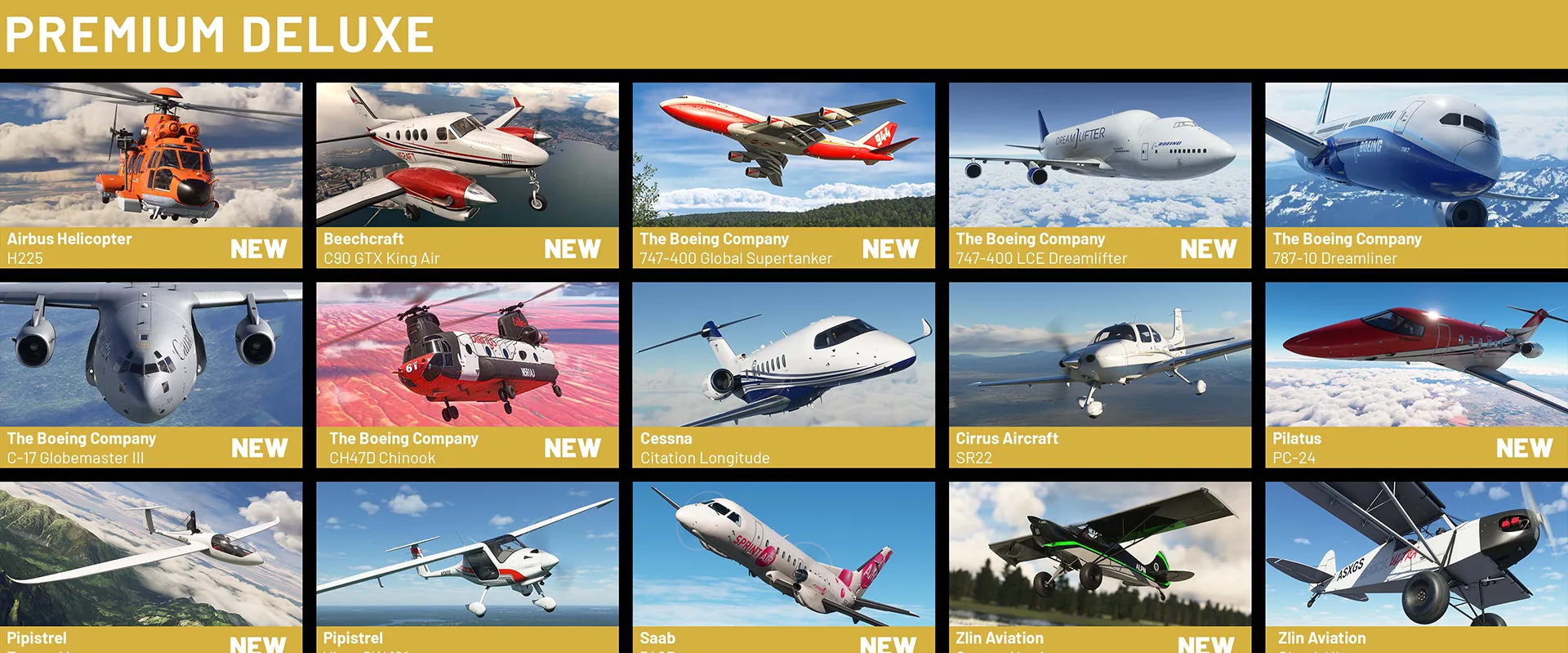
NEW in the Premium Deluxe Edition
- Airbus Helicopter H225
- Beechcraft C90 GTX King Air
- Boeing 747-400 Global Supertanker
- Boeing 747-400 LCF Dreamlifter
- Boeing C-17 Globemaster III
- Boeing CH47D Chinook
- Pilatus PC-24
- Pipistrel Taurus M
- Saab 340B
- Zlin Aviation Savage Norden
For the complete list of aircraft included in all the editions, with additional info on each new model and respective developer, check our dedicated page here.
3.3 Realistic Pre-flight and In-flight Tools
To enhance the pilot experience, Burnett detailed how Microsoft Flight Simulator 2024 brings pre-flight planning into the simulator itself. Historically, flight simmers relied on external tools for flight planning and briefing, but this will now be integrated directly into the sim. Features include:
- Electronic Flight Bag (EFB): A universal EFB is now available in every cockpit, letting pilots manage flight plans, check weather, view charts, and track aircraft systems—all in one place. Burnett emphasized that this reflects real-world technology used in modern cockpits.
- Flight Plan Integration: Flight plans created in the EFB can be seamlessly transferred into the avionics systems and vice versa. Burnett pointed out that this feature allows for real-time adjustments and modifications during a flight, making it easier to manage complex routes.
4. A Living, Dynamic World
4.1 Enhanced Global Representation
At the core of the simulator’s world is what the developers call the digital twin of Earth. This term refers to the high-fidelity recreation of the planet, using real-world data combined with cutting-edge simulation technology to bring landscapes, cities, and environments to life. Jorg Neumann explained how the new version continues to build on this foundation, incorporating fresh satellite imagery, digital elevation maps, and LiDAR data.
In Microsoft Flight Simulator 2020, users experienced photogrammetry cities for the first time. For the 2024 version, Microsoft has doubled the number of these cities, adding even more urban landscapes and further enhancing areas with LiDAR data, which provides stunning, precise detail for regions that have never been mapped this way before.
They have also focused on refining digital elevation maps to provide greater detail in mountain ranges, valleys, and other key areas.

Character Diversity
Recognizing the global nature of their product, the team took great care in representing the world’s population. “We worked with the UN, we worked with other organizations to understand how do you represent mankind appropriately, to scan hundreds and hundreds of faces all across the planet, to really capture who we are as a species,” Neumann explained. This diversity extends to the sim’s audio, with characters speaking appropriate languages based on their region.
Real-Time Shipping Traffic
A significant addition to the dynamic elements of the world in Flight Simulator 2024 is the inclusion of real-time shipping traffic. This feature adds a new layer of realism to the oceans and waterways in the simulation. To implement this feature, the MSFS team partnered with SPIRE, a data analytics company specializing in maritime, aviation, and weather tracking, and developer Henrik Nielsen, whose Global AI Ship Traffic mod for MSFS 2020 is basically being natively integrated into MSFS 2024.
New Satellite Imagery
One of the foundational improvements in Flight Simulator 2024 is the collection of fresh satellite imagery across the planet. Microsoft, in collaboration with partners at Maxar, has gathered virtually new satellite data for the entire globe. This up-to-date imagery provides the basis for a more accurate and current representation of Earth’s surface.
Digital Elevation Maps
Complementing the new satellite imagery, the team has also collected new digital elevation maps. These maps provide precise data on the height and contours of the Earth’s surface, allowing for a more accurate representation of terrain. The combination of new imagery and elevation data has resulted in what the team believes to be the most detailed version of Earth in existence.
“Countryside TIN” and High-Resolution Areas
One of the biggest innovations in Flight Simulator 2024 is the introduction of “countryside TIN” data. This ultra-high-resolution terrain data provides detail down to 50 centimeters in some areas. Microsoft has already purchased 1 million square kilometers of this high-resolution data, with plans to expand coverage. The long-term goal is to cover all of North America, Western Europe, Australia, and Japan with this level of detail.
3D Photogrammetry Cities
Building on the foundation laid in Flight Simulator 2020, the team has doubled the number of cities rendered using 3D photogrammetry. This technique creates highly detailed, three-dimensional models of urban areas, significantly enhancing the realism of city environments.
Satellite-Derived Terrain for Inaccessible Areas
For regions that are difficult or impossible to access directly, the team has developed a method of creating high-resolution terrain data from satellite imagery. This technique allows for 2-meter resolution terrain data for even the most remote locations, such as volcanoes in Kazakhstan. This ensures that every part of the world, no matter how inaccessible, is represented with a high degree of accuracy.
4.2 Aviation Infrastructure Improvements
Comprehensive Helipad Database
Flight Simulator 2024 introduces the world’s first comprehensive database of helipads. This database includes 80,000 helipads located on various structures and locations, including ships and remote rocky outcrops. The creation of this database fills a significant gap in global aviation data and will be shared with the OpenStreetMap (OSM) community, contributing to the broader field of geographic information.

Detailed Oil Rig Modeling
Recognizing the importance of oil rigs as offshore helipads, the team has modeled hundreds of oil rigs in the world. These structures are tracked in real-time, providing an unprecedented level of detail and accuracy for offshore aviation activities.

Global Glider Airport Database
Another first for Flight Simulator 2024 is the creation of a comprehensive database of glider airports. The development team went to extraordinary lengths to gather this data, contacting every glider airport in the world to collect information on the types of gliders and winches used at each location. As a result, every glider airport in the world has been handcrafted for the simulation, providing an unparalleled resource for glider enthusiasts and pilots.
Vertical Obstructions
One of the most significant safety enhancements in Flight Simulator 2024 is the inclusion of vertical obstructions. These features were entirely absent from the 2020 version of the simulator, unless a mod was installed. In fact, the developer of the most popular of such mods for MSFS, We Love VFR, is now working with the MSFS team for the native integration in the 2024 edition.
The team has accurately modeled over 1 million vertical obstructions across the globe. These include:
- Television towers
- Radio towers
- Large water towers
- Other tall structures that pose potential hazards to aviation
4.3 Wildlife and Ecosystem Simulation
Microsoft Flight Simulator 2024 introduces new procedural systems that populate the world with a living ecosystem. Jorg Neumann revealed that the simulator now includes livestock, wildlife, and even vehicles that move through the world based on real-world data. For example, wild animals like zebras, giraffes, and kangaroos roam their natural habitats, and these locations are tied to actual migration patterns.
The Importance of Animals in the Living World
In this section of the presentation, Jorg Neumann highlighted the collaboration with Johnny Watts from Frontier, a well-known developer responsible for Planet Zoo, to bring realistic animal behavior and ecosystems into Microsoft Flight Simulator 2024. This collaboration ensures that the simulation accurately represents the planet’s biodiversity, allowing virtual pilots to experience wildlife in a way never before seen in a flight simulator.
Variety of Wildlife
Microsoft Flight Simulator 2024 includes a rich variety of wild animals and livestock. These animals not only populate different regions of the world, but their behavior and location are also tied to real-world data, reflecting the actual ecosystems in which they live.
Types of Animals:
- Wild Animals: Found in their natural habitats, these species are represented with stunning accuracy, including popular animals like giraffes, zebras, kangaroos, and wildebeests.
- Livestock: Animals like cows, horses, and sheep are included, populating agricultural areas and contributing to the overall realism of the world’s ecosystems.
This is achieved by integrating databases that provide information on where certain species are located, how they migrate, and the seasonal changes that affect them.
“We migrate them over time. There’s also livestock animals, like cows or sheep or whatnot. We use our detection system… We know where the fields are, and we use those fields to put cows down or populate them with horses or sheep.“
Purpose and Interactions
One of the key aspects of integrating animals into Microsoft Flight Simulator 2024 is giving players a purpose beyond just flying. The presence of wildlife enhances the scenic experience and provides opportunities for activities like photography or aerial tours.
For instance, players can engage in activities like photographing animals in their natural habitats. The idea of snapping a picture of a group of giraffes or flying low over a herd of wildebeests brings excitement to the simulation.
One of the more unique interactions enabled by the presence of animals is sheep herding or horse herding using aircraft. In these scenarios, players can simulate real-world agricultural aviation activities, which we’ll cover ahead.
Dynamic Ecosystem
The dynamic ecosystem in Microsoft Flight Simulator 2024 ensures that animals move, interact, and live in realistic environments. Their presence is determined by factors such as geography, seasons, and migration patterns. By accurately simulating their real-world behaviors, the simulator creates an environment that feels alive and constantly evolving.
5. Career Mode and Aviation Activities
This is, without a doubt, one of the most exciting elements introduced in Microsoft Flight Simulator 2024. Jorg Neumann explained that the upcoming version will not only serve as a sandbox for flying but will also offer users structured and purposeful aviation experiences. This shift addresses a frequent request from the community, especially from gamers and digital tourists, who asked for more goals within the simulator.
Neumann emphasized, “We didn’t want to gamify the experience, but we wanted to introduce real aviation activities that reflect the authentic challenges faced by pilots.” This led to the development of an expansive Career Mode and other structured aviation experiences that guide players through a variety of aviation careers, from private pilots to commercial operators, all while preserving the simulation’s authenticity.
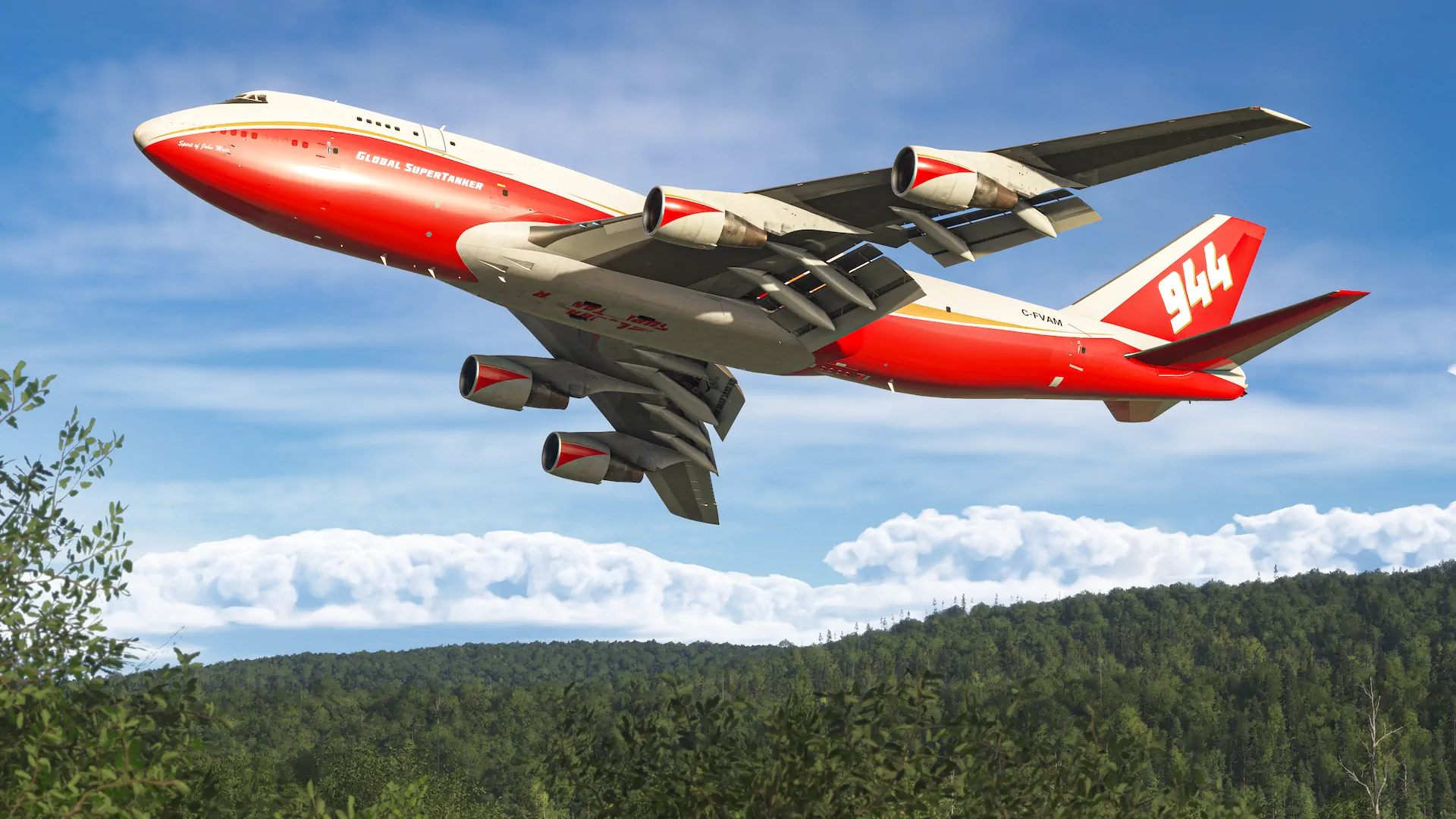
5.1 Structured Aviation Experiences
David Dedeine, Chief Creative Officer at Asobo Studio, expanded on this by introducing the broad array of aviation activities players can engage in, which range from civilian to commercial aviation operations. The activities are designed to suit a variety of moods and playstyles, from the casual digital tourist to the hardcore flight sim enthusiast. These include:
- Photographer Mode: A mode designed for users who want to explore the world’s beauty, akin to the “digital tourist” category. It allows players to capture stunning images of famous landmarks, natural wonders, and even wildlife, offering a more relaxed way to engage with the sim.
- Challenge League: A competitive mode with fast-paced, time-sensitive challenges where players can race or perform other aviation-related tasks. The Challenge League will also feature leaderboards and divisions, giving simmers a reason to return weekly for new challenges.
- Career Mode: Perhaps the most significant addition, the Career Mode allows players to start their journey as a rookie pilot, progressing through different certifications, specializations, and aviation jobs. Dedeine explained, “You start as a beginner in a small airport, working your way up through various missions and exams to unlock more advanced aircraft and licenses.”
5.2 Career Mode – Building Your Aviation Legacy
One of the most exciting additions to Microsoft Flight Simulator 2024 is the Career Mode, which offers players a detailed, long-term path through the world of aviation. According to Dedeine, Career Mode is designed to reflect the real-world progression of a pilot, from earning basic certifications to performing specialized aviation jobs.
Simmers begin their careers at a small aero club of their choice, anywhere in the world, learning the ropes with basic aircraft and earning certifications by completing training and passing exams. Over time, simmers can specialize in different aviation paths, such as Private Pilot License (PPL), Commercial Pilot License (CPL), Rotorcraft Specializations (helicopters), Transport and Search & Rescue Missions, Aerial Advertising, and more.
Career Mode includes:
- 64 different training modules: Each module focuses on a specific aspect of aviation, from basic flight operations to more complex procedures like instrument flying or rotorcraft operations.
- Certification system: As players complete training and pass exams, they unlock different licenses, such as Private Pilot License (PPL) or Commercial Pilot License (CPL). These certifications are essential for flying different aircraft types and accessing certain mission types.
- Specializations: Players can choose to specialize in areas like rotorcraft, search and rescue, or cargo transport, which lead to different career paths and missions.
Before starting each mission, simmers will be presented with one of the coolest new features in Microsoft Flight Simulator 2024: pre-flight walkarounds. Pilots can conduct detailed walkarounds of their aircraft, removing covers, checking for damages, and inspecting every part of the plane before flight.
This isn’t merely a cosmetic addition; it has tangible impacts on the experience. For instance, forgetting to remove the pitot cover will result in inaccurate airspeed readings during flight, while leaving wheel chocks in place will prevent the aircraft from moving, of course. The system encourages thorough pre-flight checks, as overlooking these details can lead to potentially dangerous situations in the air.
This feature, integrated into the new career mode, adds depth to the gameplay, requiring players to be more mindful and meticulous in their approach to each flight, just as real pilots must be.
5.3 Dynamic Mission System
The Career Mode comes with a dynamic mission system that updates daily. For example, a rescue mission may only be available for a limited time before it disappears. Dedeine explained that this system mirrors the real-time nature of the world, making each mission feel urgent and unique. “People don’t wait for you,” he noted, pointing out that the dynamic system will reflect real-world changes like weather, emergencies, and availability of contracts.
Dedeine emphasized that while the Career Mode is rooted in realism, it is designed to be accessible. “We don’t pretend to train you as a real pilot, but we wanted to capture the essence of what it feels like to earn your wings and grow your aviation career,” he said. The Career Mode introduces players to the complexities of aviation without overwhelming them with real-world regulations.
The mission system is spread across the entire world, allowing players to start their aviation careers from virtually any small or regional airport on the planet. Missions are diverse, covering a wide range of aviation tasks:
- Aerial Advertising
- Aerial Construction
- Aerial Firefighting
- Aerial Photography
- Agricultural Aviation
- Air Ambulance
- Air Racing
- Airship Tour
- Cargo Delivery
- Emergency Medevac
- Executive Transport Service
- Experimental Flight
- Firefighting
- Glider Pilot
- Helicopter Cargo Transport
- Hot Air Balloon Trips
- Industrial Cargo Transport
- Low Altitude Training
- Mountain Rescue
- Passenger Transport
- Remote Cargo Ops
- Scientific Research
- Search and Rescue
- Skydive Aviation
- VIP Charter Service
Dedeine showed a view of the mission map, revealing thousands of missions across the globe, from remote islands to bustling city airports. When zoomed out, it reveals the scale of available activities, offering an almost infinite number of jobs to undertake. “3 million missions” was a number that was thrown around, an incredible number that is only possible because they are procedurally generated.
The map itself dynamically updates, with mission icons appearing and disappearing as new tasks arise and old ones expire. This system ensures that the world of Microsoft Flight Simulator 2024 always feels alive, with new challenges constantly awaiting players.
Dedeine highlighted that each mission will come with specific parameters that pilots must follow to succeed. From proper pre-flight checks to executing a precise banner pickup in an advertising mission, attention to detail will be rewarded. Missions are evaluated on several factors, including time taken, precision, and how well the pilot managed their aircraft.
5.4 Aviation Specializations and Job Types
As players progress in their careers, they can choose to specialize in different types of aviation operations. Dedeine highlighted 16 specializations, each offering unique mission types and experiences. Some of the most notable specializations include:
- Private Pilot Operations: At the beginning of their careers, players may focus on private piloting, performing short-haul flights with friends or small-scale transport missions.
- Commercial Operations: As players advance, they can take on more complex tasks, such as transporting passengers or cargo over longer distances, often in larger aircraft.
- Rotorcraft Specializations: For those who prefer helicopters, the game offers search and rescue, medevac, and firefighting missions, where precision flying and quick decision-making are key.
- Aerial Photography and Advertising: Unique mission types allow players to perform tasks like flying over beaches to tow advertising banners or capturing photos of wildlife and landmarks.
These specializations unlock new aircraft and provide opportunities to earn more money, reputation, and experience.
5.5 Evaluation and Reputation System
As players complete missions, they are evaluated based on their performance. Dedeine explained that two main factors are used to determine the outcome of each mission:
- Mission-Specific Objectives: Each mission type has its own parameters for success. For example, in an aerial advertising mission, pilots must pick up the banner at a certain speed and altitude and then make a precise pass over the target area to drop it correctly.
- General Flight Performance: This takes into account how well the pilot handled the aircraft, including factors like avoiding overstressing the airframe, respecting ATC instructions, and proper taxiing. Even when flying for fun, simmers are evaluated on their overall performance.
These evaluations determine the reputation players earn, which impacts the types of missions they can access. As their reputation grows, players will unlock higher-paying and more complex jobs. A strong reputation also leads to bonuses and rewards, including exclusive missions that are only available to the most trusted pilots.
5.6 From Employee to Business Owner
One of the long-term goals of Career Mode is to transition players from employee pilots to independent business owners. As players accumulate wealth, they can choose to invest in their own fleet of aircraft, expanding their operations worldwide.
Dedeine explained that players will start by purchasing used aircraft, which will likely come with wear and tear, requiring regular maintenance. Over time, they can build up their fleet and even expand into owning airliners. The way players fly and treat their planes will affect maintenance costs and performance over time, adding another layer of strategy to Career Mode.
For example, hard landings or poor handling will increase the wear on landing gear and engines, leading to higher repair costs. Conversely, careful and efficient flying can help extend the lifespan of the aircraft, reducing maintenance fees.
5.7 Challenge League – A Competitive Mode
In addition to the Career Mode, Microsoft Flight Simulator 2024 introduces the Challenge League, a competitive mode where simmers can test their skills against others. Each week, players will face a new set of challenges, from low-altitude racing through mountains to short rally flights in dangerous weather. These challenges are designed to be short, fast-paced, and skill-intensive, appealing to those who enjoy competitive flying.
The Challenge League features:
- Weekly events with new challenges.
- Leaderboards and divisions, where players are promoted or relegated based on performance.
- Rewards at the end of each challenge season, providing additional motivation for simmers to perfect their flying skills.
While the Challenge League maintains the realism of the flight model, it introduces an element of fun and fast action for those who prefer quick gameplay sessions without the complexity of full-flight procedures.
5.8 Photographer Mode – Capturing the World’s Beauty
For players who fall into the “digital tourist” category, Microsoft Flight Simulator 2024 introduces the Photographer Mode, which focuses on exploration and capturing the beauty of the world. In this mode, players can take on missions to photograph famous landmarks, wildlife, and natural wonders.
The Photographer Mode missions are designed with creativity in mind. Players are tasked with finding the right angles, capturing specific elements of a scene, and sometimes timing their photos with natural phenomena such as equinoxes, sunsets, or seasonal changes. This mode offers a more relaxed, contemplative experience, allowing users to enjoy the scenic beauty of the simulated world without the pressures of complex flight operations.
6. Marketplace and Content Updates
6.1 Redesigned Marketplace: Better Discovery, Renting, and Gifting
In response to user feedback, Microsoft Flight Simulator 2024 will include a redesigned Marketplace that aims to improve the discovery and purchase of aircraft and add-ons. One of the main complaints from the community has been the difficulty in navigating the marketplace, so the team has developed a new user interface that organizes content more intuitively, with better categories and ratings.
Renting Aircraft
One of the most surprising new Marketplace features is the ability to rent aircraft. This option allows users to test out planes without fully committing to a purchase. “Not everyone is ready to spend $20 on an aircraft,” Jorg explained, “so you can rent it, try it out, and decide later.” Creators will have control over whether they want to make aircraft available for free or for a small fee, further enhancing the accessibility of the simulator.
Also, if you rent something and then decide to buy it, you’ll get a discount on the purchase price.
Gifting Options
Another addition is the ability to gift add-ons to other users. The idea behind this feature is to foster a more engaged and social community, where users can share their favorite planes with friends. This helps to lower barriers to entry and encourages more collaborative gameplay.
6.2 Updated Tutorials and Missions
The MSFS team is also focusing on improving the tutorials and mission-based gameplay in Microsoft Flight Simulator 2024. The developers have learned from the 2020 version that while many users enjoy the open-world freedom of the sim, there is a growing demand for structured activities that help guide players through more complex scenarios.
The new tutorials will be “completely reimagined“, allowing new users to gradually learn the complexities of flight without feeling overwhelmed. The team is also working on career modes and specific mission sets that give players objectives, such as completing firefighting missions with the 747-400 Global Supertanker, or participating in rescue operations with the S-64 Air Crane.
6.3 Continuous Content Updates: A Simulator for the Future
One of the reasons behind the success of MSFS 2020 is the team’s commitment to long-term updates, and things will be no different in Microsoft Flight Simulator 2024. The developers plan to provide regular sim updates, content updates, and city updates that will introduce new features, aircraft, and improvements for years to come.
The team explained that they’re listening closely to the community and are prepared to evolve the simulator based on user feedback, just has they’ve done until now.
7. Editions and Pre-Order Information
As Microsoft Flight Simulator 2024 approaches its release, the developers introduced several editions of the game to cater to different types of players. Just like in 2020, MSFS 2024 is available in Standard, Deluxe, and Premium Deluxe editions, offering varying levels of content, aircraft, and airports, allowing users to choose the package that best suits their needs. There are also several pre-order bonuses and limited-edition packages that aim to enhance the experience for early adopters and collectors.
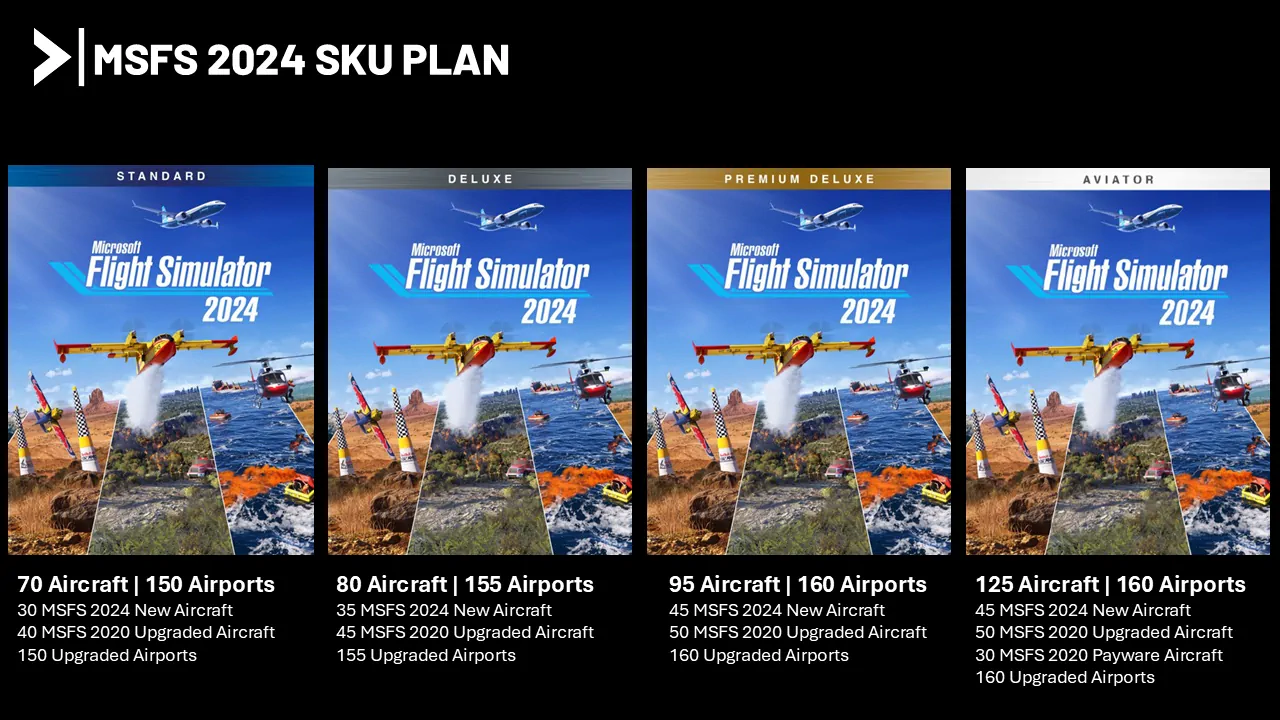
7.1 Available Editions
Standard, Deluxe, and Premium Deluxe Editions
The core platform will be available in three main versions, following the model established by Microsoft Flight Simulator 2020:
Standard Edition:
- 70 Aircraft | 150 Airports
- 30 MSFS 2024 New Aircraft
- 40 MSFS 2020 Upgraded Aircraft
- 150 Upgraded Airports
Deluxe Edition:
- 80 Aircraft | 155 Airports
- 35 MSFS 2024 New Aircraft
- 45 MSFS 2020 Upgraded Aircraft
- 155 Upgraded Airports
Premium Deluxe Edition:
- 95 Aircraft | 160 Airports
- 45 MSFS 2024 New Aircraft
- 50 MSFS 2020 Upgraded Aircraft
- 160 Upgraded Airports
Interestingly, users will also be able to buy certain planes in the Deluxe editions (like the 787) individually if that’s all they want, rather than buying a whole package.
The New Aviator Edition
This time, Microsoft is introducing a fourth edition, the Aviator Edition, a new package created to appeal to dedicated fans of the simulator who want everything in one bundle.
The Aviator Edition includes all the content from the Premium Deluxe Edition, along with all the Local Legends and Famous Flyers aircraft released until now. That is 30 more airplanes, for a total of 125!
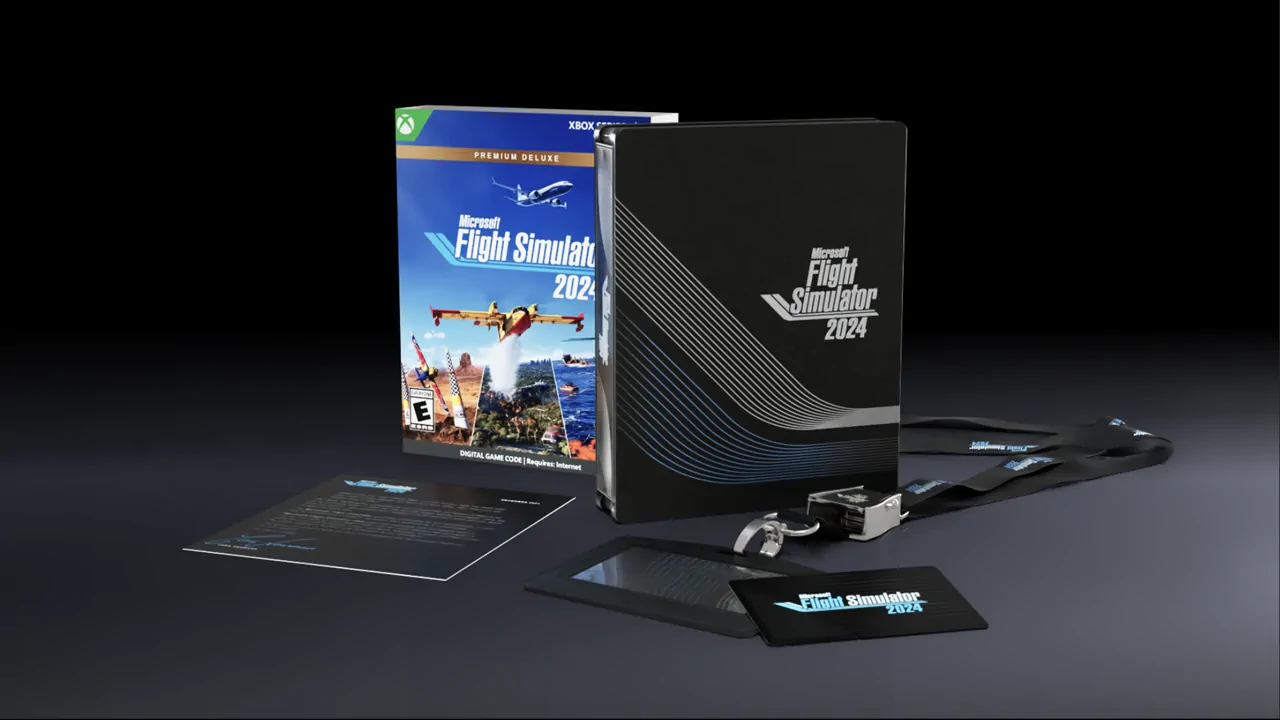
Steelbook Edition
For fans of physical media, Microsoft has also introduced a Steelbook Edition of the Premium Deluxe package. This edition will feature a premium metal case to house the game’s physical discs.
Limited Collector’s Edition: The Antonov An-225 Tribute
Finally, the most unique offering announced was the Limited Collector’s Edition, which pays tribute to the legendary Antonov An-225 Mriya. This package will include a physical model of the aircraft, a flight bag, pins, and other memorabilia. It will be limited to just 5,000 copies worldwide.
7.2 Pre-Orders and Exclusive Content
Pre-orders for Microsoft Flight Simulator 2024 are now open, and the developers have prepared a nice pre-order bonus for early adopters. The pre-order window will remain open until the day before the game launches, giving players ample time to secure their preferred edition.
Those who pre-order will have exclusive access to the Canadair CL-415, a water-bomber aircraft that has become iconic for its role in firefighting missions. This plane, which features prominently in the key art for the new sim, will be available to pre-order customers as part of MSFS 2020, giving players something to enjoy while they wait for the new edition.
8. Conclusion
Microsoft Flight Simulator 2024 is set to represents a significant leap forward in the world of flight simulation. Building on the success of its predecessor, this new iteration brings a host of technological advancements, an expanded fleet of aircraft, a more dynamic, living world for players to explore, and an in-depth Career Mode that promises to keep simmers engaged in their own virtual aviation adventure!
If you’re looking to learn more about some specific detailes about Microsoft Flight Simulator 2024, check out our extensive coverage leading up to the release. Exciting times ahead! As the MSFS team says, the sky is calling!












